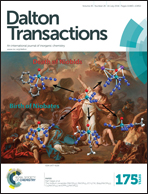Merging of memory effect and anion intercalation: MnOx-decorated MgAl-LDO as a high-performance nano-adsorbent for the removal of methyl orange†
Abstract
MnOx-decorated MgAl layered double oxide (M-LDO) was fabricated via merging of memory effect and anion intercalation, accompanied by the reduction/calcination process. The as-obtained nanocomposites were characterized by scanning electron microscopy (SEM), high resolution transmission electron microscopy (HRTEM), powder X-ray diffraction (XRD) and N2 adsorption–desorption. To clarify the detailed formation mechanism, optimized calcination temperature/time and temperature for methyl orange (MO) adsorption were investigated. Adsorption experiments showed that the adsorption behaviour fitted well with a Langmuir isotherm and pseudo-second-order model, and the maximum adsorption capacity calculated from the Langmuir model was 555.55 mg g−1. The adsorption process was exothermic and spontaneous in nature. Moreover, the used adsorbent could be regenerated for at least five cycles (94% removal retained) through a thermal procedure, indicating that the M-LDO hybrid is a promising adsorbent with promising ability to remove anionic dye pollutants from wastewater.


 Please wait while we load your content...
Please wait while we load your content...